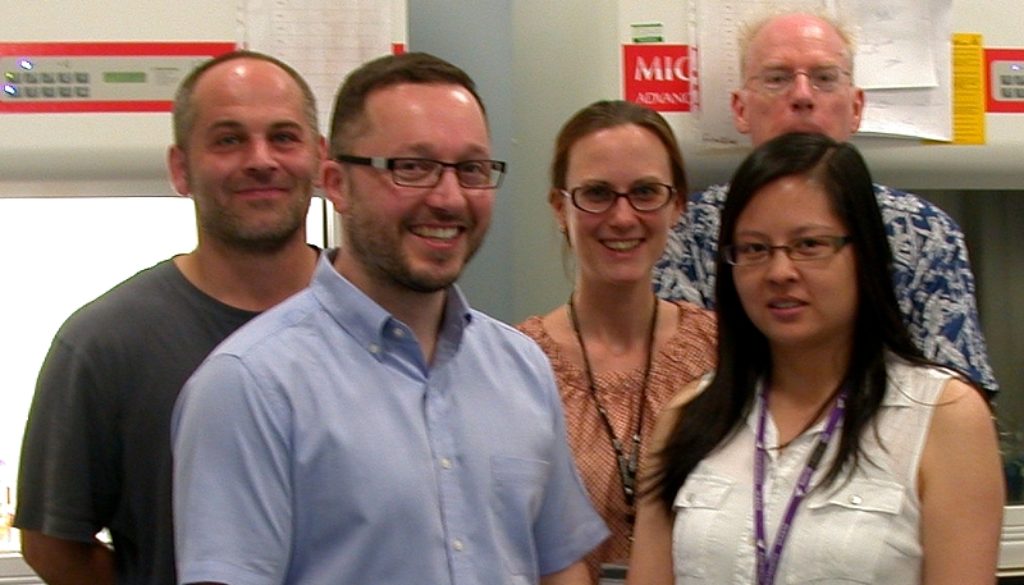Interview with Dr Elizabeth Woehrling

Dr Elizabeth Woehrling is a Chemistry and MSc Toxicology graduate, with a PhD and extensive professional experience in In Vitro Neurotoxicology. She is Research Associate at Aston University, Birmingham, in Prof MD Coleman’s laboratory and took part in our study of the effects of pesticide cocktails on neuronal cells. She possesses a genuine interest in the field of alternatives research, communication and scientific acceptance of human based methods. She is member of the European Society of Toxicology In Vitro (ESTIV). She was invited to the European Centre for the Validation of Alternative Methods (ECVAM) to brief the Neurotoxicity Group on her (and Prof Coleman’s team) co-culture model.
Antidote Europe (AE) : How did you come by the use of in vitro methods in your research at a time when using laboratory animals is still common?
Elizabeth Woehrling (EW) : I have been a vegetarian and advocate of animal welfare since my teens. Following my MSc in Toxicology I got a job with a cancer prevention unit. Most frequently I was examining human samples, breast tissue etc gained during biopsies and surgery, for biomarkers of cancer but occasionally was required to test organs from experimental animals. At this point (10 years ago) I started reading more about replacement toxicology and determined I would like a proactive role in this emerging field. I contacted my now colleague Prof Coleman as he was a well-known figure in vitro toxicology and luckily found he had funding for a PhD student to study Neurotoxicology, by developing a model of the brain using human cells. This was a double bonus as a lot of in vitro work then and now involves using animal cells and although that greatly reduces the numbers of animals involved in experimentation it may not provide the data most relevant to the human situation. I undertook a PhD with Prof Coleman, funded by the Humane Research Trust (HRT) who fund replacement research and followed now by 2 post-doctoral fellowships, the first funded by the HRT and the second by the British Brain Research Fund, who fund research into neurological conditions. It was good that the BBRF saw the potential of the use of in vitro human based methods in this area. Our driving aim then as now is not just the issue of animal welfare but the development of models and methods that better reflect the human condition, human based models which hopefully in the future will provide data on chemical toxicity that is simply more relevant to humans that that derived from animals. It a huge undertaking, especially for small University groups such as ours with limited man power and resources, compared with the larger devoted organisations in Europe and the USA but the more people working to the same aim the better.
AE : What is your particular area of research?
EW : Within Prof Coleman’s Neurotoxicology group we have developed a human cell-based, post-mitotic, neurotoxicity model from the Ntera2 cell line which may be differentiated to give a co-culture of central nervous system (CNS) neurons and astrocytes (NT2.N/A). We have begun to validate it with known human neurotoxins and a battery of general biochemical endpoint assays and assays specific to neurons and astrocytes. Application of this in vitro human-based system has the potential to greatly increase throughput of the preliminary neurotoxin screening process compared with traditional animal studies in a relevant and ethical human manner. The model is flexible and has other potential applications outside the immediate sphere of neurotoxicology and most recently we have established the cholinergic functionality of the NT2 neuronal and astrocytic co-culture model (NT2.N/A) and developed it to determine the anticholinergic potential of drugs in isolation and combination, using fluorescent calcium imaging. Experimental and clinical studies have revealed a strong link to exist between the anticholinergic functionality of medications and acute cognitive impairment in older adults but to date no relevant human CNS model exists to rank the anticholinergic potential of commonly used combinations of such drugs. Parallel studies include the adaptation of the NT2.N/A cells to animal-product free culture conditions and identification of specific biomarkers of neurotoxicity for use in in vitro, repeat-dose safety testing of drugs and cosmetics.
AE : You recently published a paper describing the use of a synthetic growth medium to replace the traditional use of fetal calf serum for your cell cultures. Would you say that science is at the point where all use of fetal calf serum could be substituted with synthetic alternatives? [If not, is it because of tradition or that the necessary technology is still evolving?]
EW : The answer is two-fold. Firstly, whilst a recent advance in cell culture is the development of defined animal-origin free FBS replacements and compatible culture media, the technology is still evolving regarding individual cell types. Secondly the timescale and cost of fully adapting and verifying a cell line is large. I can only really answer fully regarding differentiation of the cell-line we employ, namely the human Ntera (NT2) cell-line from which we derive post-mitotic NT2 neurons and astrocytes (NT2.N/A). This cell line was established over 30 years ago and since then a large number of groups have developed the differentiation procedure and have characterised the resulting cells (using a wealth of different protein markers etc for neurons and astrocytes) to determine and verify their post-mitotic, CNS nature and functionality. It is not simply a case of choosing to grow the cells in serum-replacement medium. Firstly the undifferentiated cells must be adapted stepwise to the new medium which can take weeks-months. Then the differentiation process itself must be adapted. As serum contains albumins which bind a number of chemicals used in the differentiation process, without FBS in the medium many of these (now unbound) compounds may prove toxic at their usual concentrations. Thus new, non-toxic but still effective working concentrations must be established.
KnockOut™ DMEM (Life Technologies, UK) is a recently developed, chemically defined, animal-component free basal medium designed to optimize the growth and differentiation of pleuripotent stem cells when supplemented with GIBCO® KnockOut™ serum replacement. However, the innovative properties of such products come at a cost up to10 fold that of their animal derived counterparts. Funding bodies are often not able/willing to factor in these extra costs and also it takes a large number of man-hours to adapt a cell model to growth under new conditions and prove it is functioning normally and with identical characteristics and a similar expected lifespan compared with the original FBS supplemented cell line. Without the LUSH Prize I would have been unable to begin to investigate and develop the growth of our neuronal and astrocytic cells in such an FBS-free and defined manner. But there is a long way to go in the adaptation and verification process until we can confirm the cells are identical to those NT2 neurons and astrocytes differentiated over the last 20-30 years.




